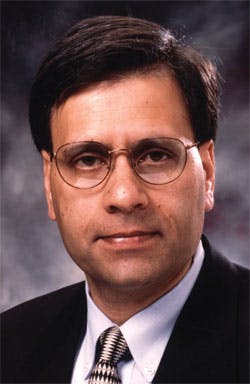Somebody messed up.
There is a rattle in the new turbine -- an imperceptible vibration deep down; something mute and slight, nearly undetectable.
Once it registers on the diagnostics, though, the team at GE (IW 500/6) knows what it means: It means trouble. It means that something went wrong somewhere in one of the hundreds of plants around the world that supplied one of the thousands of parts that went into the turbine. It means somebody messed up. And it means that they will have to fix it before delivery.
Just a couple of years ago, this would have been a forensic nightmare. It would have meant tearing the thing apart piece by piece, meticulously inspecting each component until they found the problem. It would have meant digging through volumes of production data and notes about each step of the process to find where the problem began and figure out how far it stems. It would have meant months of work, months of delays, months of lost time.
But that's not what it means today.
"We've digitized the manufacturing process," explains Don Busiek, general manager of Manufacturing Software at GE Intelligent Platforms. "The performance of every manufacturer or every piece of our turbines can be tracked online. So if there is a problem like this, I can have answers in seconds, not months."
Diagnostic teams at GE, he says, now have information on every handler, every process and every quality check performed on every part of every machine right at their fingertips. And that's just one piece of the high-tech toolbox they have on hand to help create operational efficiency and performance -- just one of the countless high-tech tools coming out every day to help them make better high-tech goods.
"We are at an inflection point from a technology perspective where we have the opportunity to do things we've never been able to do before and to manufacture things better than we ever could before," Busiek explains.
What's more, this inflection point marks a significant change in the manufacturing leadership hierarchy.
Efficiency and productivity, maintenance and quality have always been operational issues -- what we have always looked to the COO's department to bring. But as manufacturing gets digitized, the new time-saving and efficiency-boosting tools are now coming from a powerful new (or newly powerful) manufacturing leader: the CTO.
"We're no longer looking to operations for help," Busiek says. "It's the CTO that has stepped up as the new hero on the plant floor."
She Who Controls the Data...
Padmasree Warrior takes this elevated status in stride.
The visionary chief technology and strategy officer for Cisco (IW 500/30) and one of the architects of its much-lauded "Internet of Everything," Warrior is on the leading edge of the high-tech manufacturing movement and is positioned at the very top of the new C-suite power structure. But even she balks at this "hero" status.
"I can't say that I'm the hero of anything," she laughs. "However, I can say that my role has changed quite a lot over the last six years. But so has the industry."
Since Warrior took her position at Cisco in 2008, manufacturing has undergone a dramatic technological makeover. Called the manufacturing renaissance by some or the Industrial Internet or Connected Enterprise by others, it has put manufacturing at the head of the uber-connected, data-rich, analytics-driven Internet of Everything economy. And that's an economy Cisco says should be worth around $19 trillion or so in the next eight years.
"This movement is transforming every industry and every business, starting with manufacturing," Warrior says. "It starts with more machines getting connected and more devices communicating. That leads to the transformation of manufacturing: a lot more robots, a lot more automation, a lot more simulation, a lot more data to be analyzed, a lot more systems that can be optimized."
In other words, technology has emerged from the IT basement and implanted itself at the very heart of manufacturing and, indeed, at the very heart of 21st-century business.
"At this point, we believe that every company, big and small, is essentially becoming a technology company," Warrior says. "Technology has become implicit and embedded in every business process today -- the supply chain, manufacturing floor, automation and IT: They are all driven by technology and data analytics, not just operational expertise."
So in this sense, the rise of the CTO seems much less an act of heroics than a natural evolution of a changing power dynamic.
She who controls the technology, one could say, controls the enterprise.
The Business of Technology
Over the last decade, the infusion of technology has fueled what seems like constant C-suite renovations. There are suddenly mobility and innovation officers in the mix; there are chief data scientists and creative officers driving entirely new departments devoted to exploring and exploiting new areas of high-tech business.
So what makes the CTO so important all of a sudden?
According to GE's Busiek, this new breed of CTO has found itself straddling two sides of the manufacturing business with a foot firmly planted in each.
"The manufacturing-savvy CTOs can leverage technology to increase productivity and quality all the way down on the plant floor -- down on the basic machine level," he says. "The business-savvy CTO can use these technologies to expand business to help connect better products with a bigger customer base."
And in those rare cases of the manufacturing- and business-savvy leader? "That's a scenario where, if done correctly, the CTO could be the reason why one company outperforms the competition," Busiek says. "The CTO could be the sole reason why one company ends up dominating an industry."
And that gives the position a bit of heft over the newcomers.
"The role of the CTO is no longer just to enable technology," notes Sujeet Chand, chief technology officer at Rockwell Automation (IW 500/165). "Our role is to use that technology to help move the business forward."
And that all comes down to convergence, he says. Convergence between the digital and physical worlds, between the workers and the products they make, between technology and the business.
"It's all part of the convergence between IT and OT," Chand explains. "To really get value from that convergence, you've got to highlight what value is going to be derived. You don't want to connect manufacturing to IT for the sake of connecting manufacturing to IT or put all kinds of real-time data into the cloud for no reason."
The CTO's role, he says, is to enable this convergence and to keep it tied directly to value and value gain -- to bring all of those different pieces together to improve the business as a whole.
That's an idea with which Alcoa (IW 500/53) CTO Ray Kilmer certainly agrees.
"Ultimately, it's the CTO that is developing the future of the business," he says. "Really, they are the ones that are going to be the difference makers as to whether the business fails or succeeds."
"Of course there are other people on the team like the CFO and the CEO making critical decisions," he adds. "But if you have a weak CTO, it is an absolute recipe for business disaster. Without question."
Evolution of a Leader
This new role marks a significant evolution of the CTO's domain and, really, the department's basic mission.
"Twenty years ago, the role of the CTO was unrecognizable to what it is today," explains Warrior. "Back then, the CTO was essentially just the chief scientist, taken straight from a national lab or university to work behind the scenes in R&D."
"We developed new products, a few new processes," she says. "But the CTOs were generally there for support."
Now, however, she has seen her office moved from a supporting role locked in IT to one leading the business from the front and, notably, the one responsible for meeting the traditional metrics of success.
"While the technical content to my job is obviously very heavy, the business content has gone up tremendously in the past six years," she says. "I now worry a lot about productivity. I focus more on what we deliver to our customers and what we can do internally to improve it."
"I'm not just driving technology anymore," she says. "I'm applying technology to solve business problems; I'm using it to drive productivity and agility. Essentially, I'm using technology to cover what traditionally were COO or CFO focus areas."
And that is what excites GE's Busiek the most.
"If you're a manufacturing company, the manufacturing and the production in that plant are the crown jewels," he says. "It doesn't matter what industry it is, if it's food or aerospace, that manufacturing plant and the overall yield and production of it is the most important thing you have."
If you can improve them, he says, if you can affect quality or output, if you can boost productivity or efficiency, you can change the whole business. And that is exactly what this new generation of CTO leaders are doing.
"There is the opportunity now for the CTO to become a real hero in manufacturing," Busiek says. "All of a sudden we have the ability to leverage technology as a competitive differentiator throughout the business and throughout the manufacturing plant."
|
See how these connected technologies are
impacting manufacturing at: |
"When the CTO stands up to be the hero," he says, "it's an opportunity to transform the whole industry."






